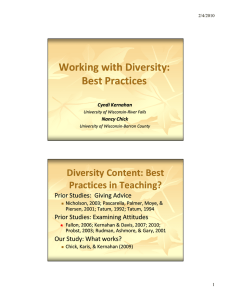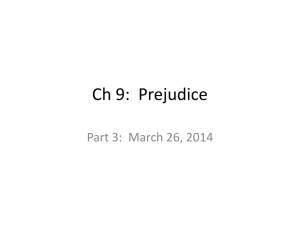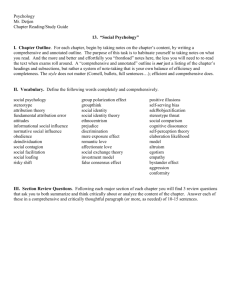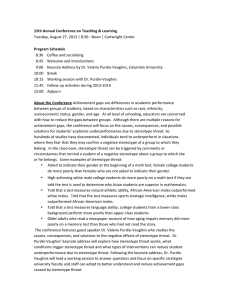The Effects of Societal Versus Professor Stereotype Threats on
advertisement
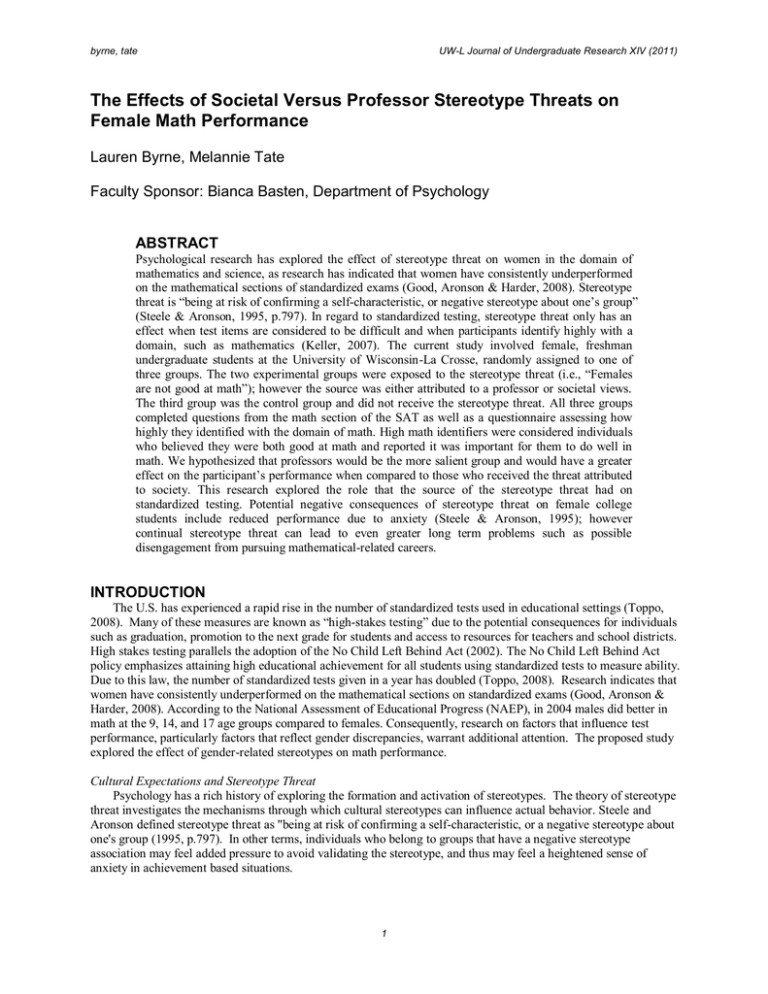
byrne, tate UW-L Journal of Undergraduate Research XIV (2011) The Effects of Societal Versus Professor Stereotype Threats on Female Math Performance Lauren Byrne, Melannie Tate Faculty Sponsor: Bianca Basten, Department of Psychology ABSTRACT Psychological research has explored the effect of stereotype threat on women in the domain of mathematics and science, as research has indicated that women have consistently underperformed on the mathematical sections of standardized exams (Good, Aronson & Harder, 2008). Stereotype threat is “being at risk of confirming a self-characteristic, or negative stereotype about one’s group” (Steele & Aronson, 1995, p.797). In regard to standardized testing, stereotype threat only has an effect when test items are considered to be difficult and when participants identify highly with a domain, such as mathematics (Keller, 2007). The current study involved female, freshman undergraduate students at the University of Wisconsin-La Crosse, randomly assigned to one of three groups. The two experimental groups were exposed to the stereotype threat (i.e., “Females are not good at math”); however the source was either attributed to a professor or societal views. The third group was the control group and did not receive the stereotype threat. All three groups completed questions from the math section of the SAT as well as a questionnaire assessing how highly they identified with the domain of math. High math identifiers were considered individuals who believed they were both good at math and reported it was important for them to do well in math. We hypothesized that professors would be the more salient group and would have a greater effect on the participant’s performance when compared to those who received the threat attributed to society. This research explored the role that the source of the stereotype threat had on standardized testing. Potential negative consequences of stereotype threat on female college students include reduced performance due to anxiety (Steele & Aronson, 1995); however continual stereotype threat can lead to even greater long term problems such as possible disengagement from pursuing mathematical-related careers. INTRODUCTION The U.S. has experienced a rapid rise in the number of standardized tests used in educational settings (Toppo, 2008). Many of these measures are known as “high-stakes testing” due to the potential consequences for individuals such as graduation, promotion to the next grade for students and access to resources for teachers and school districts. High stakes testing parallels the adoption of the No Child Left Behind Act (2002). The No Child Left Behind Act policy emphasizes attaining high educational achievement for all students using standardized tests to measure ability. Due to this law, the number of standardized tests given in a year has doubled (Toppo, 2008). Research indicates that women have consistently underperformed on the mathematical sections on standardized exams (Good, Aronson & Harder, 2008). According to the National Assessment of Educational Progress (NAEP), in 2004 males did better in math at the 9, 14, and 17 age groups compared to females. Consequently, research on factors that influence test performance, particularly factors that reflect gender discrepancies, warrant additional attention. The proposed study explored the effect of gender-related stereotypes on math performance. Cultural Expectations and Stereotype Threat Psychology has a rich history of exploring the formation and activation of stereotypes. The theory of stereotype threat investigates the mechanisms through which cultural stereotypes can influence actual behavior. Steele and Aronson defined stereotype threat as "being at risk of confirming a self-characteristic, or a negative stereotype about one's group (1995, p.797). In other terms, individuals who belong to groups that have a negative stereotype association may feel added pressure to avoid validating the stereotype, and thus may feel a heightened sense of anxiety in achievement based situations. 1 byrne, tate UW-L Journal of Undergraduate Research XIV (2011) There is a large body of research on race and the stereotype threat (Steele and Aronson, 1995; Steele, 1997; Steele, Spencer, & Aronson, 2002). In addition, a growing body of research expands on a gender aspect of stereotype threat, specifically to the affect of stereotype threat on women’s math skills performance. Spencer, Steele, and Quinn (1999) found when these stereotype threats are high, and respondents have been told their performance on the task will be diagnostic of their skills, women are less able to answer mathematical questions. However, in these studies, when the threat was not present, performance rates between males and females were the same. This study shows that when the cultural stereotype is made salient to women, their performance on a stereotype related skill suffers. It is important to note however, that stereotype threats only have an effect when the test items are considered to be difficult (Keller, 2007). Keller (2007) also found that stereotype threat has a greater effect on performance for those who identify highly in math compared to low math identifiers. This study assumes low domain identifiers do not experience an intense enough pressure in the testing situation, and a failure on the test would not have a strong effect on their self-concept compared to someone who identified highly with mathematics. Not only do stereotype threats inhibit academic success, there are other potential negative consequences. The immediate consequence that can occur due to a stereotype threat is reduced performance due to anxiety (Steele & Aronson, 1995). However, the long-term consequence may result in distancing from the group that is stereotyped (Aronson, Fried, & Good, 2002). Within an educational context, college students who persistently experience stereotype threat in agreement with their academic performance may become disengaged from those academic pursuits. For example, if a female college student is consistently introduced to the stereotype threat that women do worse on math, and her grades are not good, she will not pursue a future with math. This idea may help to explain why there is a deficit of females in jobs that require high mathematical skills. Shapiro (2007) implicated stereotype threats arise due to two significant factors, the target of the threat as well as the source. Different sources do not need to be present during the stereotype threat; however it is essential that the target of the negative stereotype threat needs to believe the source of the threat will have later access to information about their performance. It is the aim of the current study to focus on the source of the stereotype threat, being either popular culture or professors. Source of Messages Teacher expectations have also been implicated as affecting student academic performance. Initial research of teacher expectations began with the work of Rosenthal and Jacobson (1968) regarding self-fulfilling prophecy. Selffulfilling prophecy is the effect of one’s expectation actually leading to the fulfillment of the expectation. Rosenthal and Jacobson sought to examine if teacher expectations influenced student performance. They informed elementary school teachers some students were higher achieving than others based on IQ test scores, when in reality the students were randomly assigned independent of IQ scores. After eight months a real IQ test was given and the students said to be low achieving showed an increase in their IQ scores compared to the students in the control group and were evaluated positively by their teachers. Rosenthal (2002) later found student performance was impacted by teacher expectations thirty six percent of the time. However, the influence of teacher expectations does not amass over time. Rather, it seems to lessen as students move from one grade level to the next (Smith et al., 1999). As a result of Rosenthal and Jacobson’s original work on self-fulfilling prophecy and teacher expectancy effects, a strong body of literature has emerged. The majority of research in this field recognizes that teacher expectations influence student academic performance (Brophy, 1983; Cooper, 1979; Dusek, 1985; Finn, 1972; Smith, 1980). The role of teachers influence regarding message promotion can also be understood under a larger body of research literature that examines how the credibility of a source can affect behavior. Olson (1984) found an effect of source credibility on behavior occurring when the source varied, labeled as either high or low credibility. The participant’s behavior varied accordingly; high credibility sources having more influence on subjects than low credibility sources. Another study (Bochner, 1996) found that even when a message was highly discrepant, highly credible sources had the ability to change opinion more than medium or low credibility sources. Highly credible sources are also liked and trusted more than medium credibility sources, regardless of the message they are saying. Therefore, this study will use professors as the source, instead of teachers, to insure there is high enough source credibility present. Additionally, Source Credibility Theory (Hovland, 1953) identified two major factors that influence source credibility – source expertise and perceived source trustworthiness. This suggests that an individual person could be much more likely to be perceived as an expert and as more trustworthy than an entire group of “nameless” individuals. The current study will explore the impact of stereotype threat on the standardized test performance, specifically math skills, of freshman females enrolled at a four-year university. The source of the threat was manipulated, being either popular culture or professors. Based on current research, it is hypothesized that the professor source of threat 2 byrne, tate UW-L Journal of Undergraduate Research XIV (2011) will have a greater impact on the female’s math skills performance than the societal source of threat as the professor group is the more salient group in a college female’s life. METHODS Participants Participants included 52 female freshmen undergraduate students, under the age of 20, from the University of Wisconsin-La Crosse. All females were enrolled in a General Psychology class and received extra for participation. 98% of participants were Caucasian, while 2% were Hispanic. All individuals participated on a voluntary basis, and informed consent was obtained prior to the study. Procedure Participants were randomly assigned to one of three conditions – a societal source, a professor source, or a control group. The cultural source group was prompted to read a passage informing them of a culturally accepted stereotype against women’s ability to perform math related skills, as reported from a national organization, compared to males. The professor source group was prompted to read the same passage, only informed the stereotype came from a nameless freshman mathematics professor at the University of Wisconsin-La Crosse. The control group was prompted to read a passage about the extracurricular activities available for freshman on campus. After having read the passage, participants were given 12 SAT sample math questions. The societal source and professor source group were informed prior to testing the results would be compared to those of other freshman, while the control group was informed to complete the assessment to the best of their ability. After testing, participants were asked to complete a survey assessing perceived test difficulty, self-estimated test score, math domain identification, credibility of source, comprehension of the passage read, as well as demographic information. RESULTS Our hypothesis that the professor threat source group would lead to lower test scores was not supported. A oneway ANOVA comparing condition and test score showed no significance, as well as no significance between the two experimental groups and the control group. Although the results provided no significance, the societal stereotype threat source group scored the lowest of the three conditions (M=4.09, SD=1.48). See Figure 1. 12 Mean Test Score 11 10 9 8 7 6 5 5.0769 4.9444 4.0952 4 3 2 1 0 Control Societal Professor Figure 1. Mean test score compared by condition 3 Mean Test Score byrne, tate UW-L Journal of Undergraduate Research XIV (2011) Additionally, correlations between test scores and perceived test difficulty, self-estimated test scores, and math domain identification were analyzed. No significant correlation was found between test scores and perceived test difficulty (p=.173), self-estimated test score (p=.266), and math domain identification (p=.542, p=.120). DISCUSSION Contrary to our hypothesis, the results did not show any significant differences when comparing the societal threat source group to the professor threat source group. We also did not find any statistically significant differences between the two experimental source groups with that of the control group. These findings are inconsistent with previous research found, however possible limitations could have interfered affecting the results. Due to the low scoring received on the math test across all three conditions, we can suggest that the test was too difficult for participants. High-test difficulty can help account for the lack of variance observed between the scores. Another possible limitation to the study was that the stereotype threat did not have a strong enough manipulation effect on the experimental groups. As mentioned previously, in order for a stereotype threat effect to occur, the situation needs to be both anxiety provoking and difficult. Although the test demonstrated high difficulty, the threat may have not induced enough anxiety in participants to inhibit performance further. A possible explanation for the ineffectiveness of the stereotype threat is a lack of motivation. Participants may not have felt intrinsically motivated to perform well on this test. It would have also been helpful if we had a more diverse testing group, due to the majority of participants being Caucasian. A manipulation check did however indicate that participants remembered the source of the stereotype threat, suggesting that most participants understood the differing source groups. Although no significant results were found, the source of stereotype threats is a prevalent topic that deserves further research. Future research could examine the differences that source has on stereotype threat by making the stereotype threat more powerful. Different populations could be used to see if more of an affect occurs on younger aged school kids compared to college-aged participants. This research could aid in understanding if specific sources have more of an effect or if certain populations are more at risk for confirming to stereotype threats. This knowledge could be taken into account when educating math professionals, making sure they are aware of the effect stereotype threat can have on female math performance. ACKNOWLEDGMENTS We would like to recognize our research advisor, Bianca Basten, for her guidance and support. We would also like to thank the UW-L Undergraduate Research Grants Program for funding our research and allowing us the opportunity to expand our knowledge of the research process. REFERENCES Aronson, J., Fried, C., & Good, C. (2002). Reducing the effects of stereotype threat on African American college students by shaping theories of intelligence. Journal of Experimental Social Psychology, 38, 113-125. Bochner, S., & Insko, C. (1966). Communicator discrepancy, source credibility, and opinion change. Journal of Personality and Social Psychology, 4(6), 614-621. Brophy, J. E. (1983). Research on the self-fulfilling prophecy and teacher expectations. Journal of Educational Psychology, 75, 631-661. Cooper, H. (1979). Pygmalion grows up: A model for teach expectation communication and performance influence, Review of Educational Research, 49, 389-410. Dusek, J. B. (1985). Teacher expectancies. Hillsdale, NJ: Lawrence Erlbaum. Finn, J. (1972). Expectations and the educational environment. Journal of Educational Research, 42, 387-410. Good, C., Aronson, J., & Harder, J. (2008). Problems in the pipeline: Stereotype threat and women's achievement in high-level math courses. Journal of Applied Developmental Psychology, 29(1), 17-28. Hovland, C.I., Janis, I.L., & Kelley, H.H. (1953). Communication and Persuasion. New Haven, CT: Yale University Press Keller, J. (2007). Stereotype threat in classroom settings: The interactive effect of domain identification, task difficulty and stereotype threat on female students' math performance. British Journal of Educational Psychology, 77(2), 323-338. Perie, M., and Moran, R. (2005). NAEP 2004 Trends in Academic Progress: Three Decades of Student Performance in Reading and Mathematics (NCES 2005-464). U.S. Department of Education, Institute of Education Sciences, National Center for Education Statistics. Washington, DC: Government Printing Office. Olson, J., & Cal, A. (1984). Source credibility, attitudes, and the recall of past behaviours. European Journal of Social Psychology, 14(2), 203-210. 4 byrne, tate UW-L Journal of Undergraduate Research XIV (2011) Rosenthal, R. (2002). Covert communication in classrooms, clinics, courtrooms, and cubicles. American Psychologist, 57, 839-849. Rosenthal, R., & Jacobson, L. (1968). Pygmalion in the classroom: Teacher expectation and pupils' intellectual development. New York: Holt, Rinehart & Winston. Shapiro, J., & Neuberg, S. (2007). From stereotype threat to stereotype threats: Implications of a multi-threat framework for causes, moderators, mediators, consequences, and interventions. Personality and Social Psychology Review, 11(2), 107-130. Smith, A., Jussim, L., & Eccles, J. (1999). Do self-fulfilling prophecies accumulate, dissipate, or remain stable over time? Journal of Personality and Social Psychology, 77, 548-565. Smith, M. (1980). Meta-analysis of research on teacher expectation. Evaluation in Education, 4, 53-55. Spencer, S. J., Steele, C. M., & Quinn, D. M. (1999). Stereotype threat and women's math performance. Journal of Experimental Social Psychology, 35, 4-28. Steele, C. (1997). A threat in the air: How stereotypes shape intellectual identity and performance. American Psychologist, 52(6), 613-629. Steele, C., & Aronson, J. (1995). Stereotype threat and the intellectual test performance of African Americans. Journal of Personality and Social Psychology, 69(5), 797-811. Toppo, G. (2004, October 12). An answer to standardized tests. USA Today. Retrieved from http://www.usatoday.com. 5

